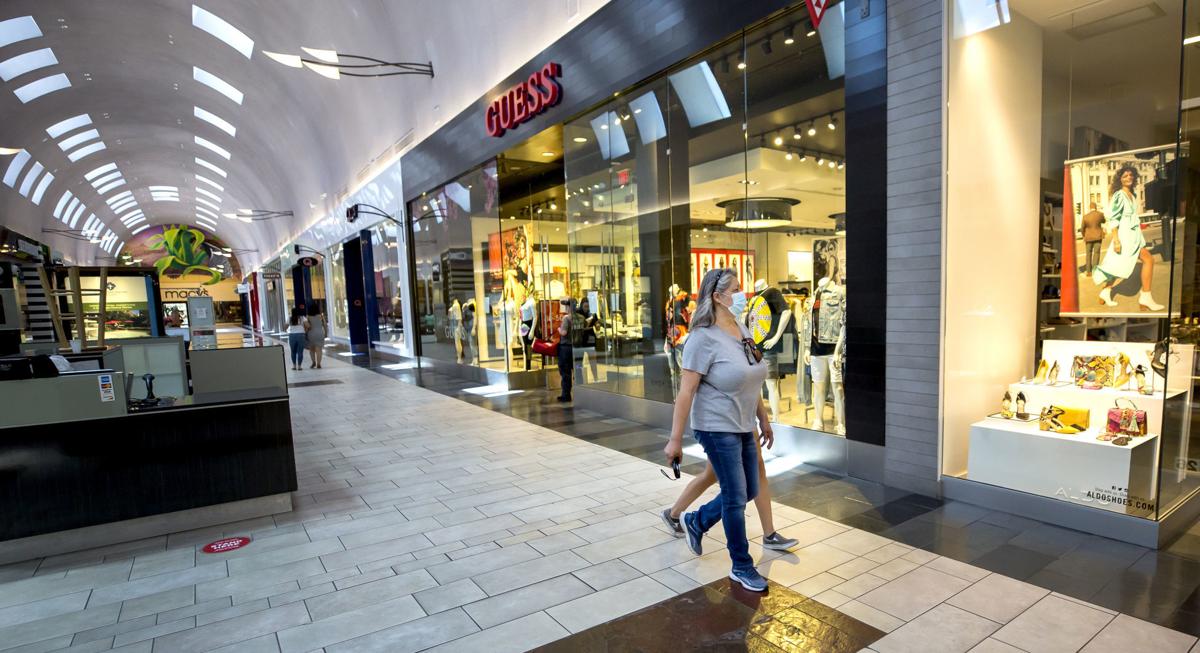More than 1.6 million Arizonans are now collecting some form of jobless benefits as the Arizona economy continues to skid and the number of people with COVID-19 continues to increase.
New figures from the state Department of Economic Security show that as of last week there were 234,089 individuals collecting under the state’s regular unemployment insurance program.
But that pales in comparison to the more than 1.4 million who are getting paid under the federally created Pandemic Unemployment Assistance program. That is for those who do not qualify for regular state benefits, ranging from those who were self-employed and contractors — people not considered part of the traditional state labor force of about 3.4 million — to those whose prelayoff wages do not qualify them for Arizona’s unemployment program.
Potentially more alarming is that the number of Arizonans seeking jobless benefits is again on the rise.
DES says 28,522 individuals filed first-time claims last week. That’s up 17% from the week before.
And that figure, in turn, is nearly 11% higher than the prior week.
The numbers still are far below what they were after Gov. Doug Ducey closed what he said were nonessential businesses and imposed a stay-home order when, in one week alone, more than 132,000 people filed for benefits.
Economist Elliott Pollack said the figures are surprising.
“It’s a different trend than the national trend, which continues down,” he said.
All this comes as Arizona set another record Tuesday with 2,392 new cases of COVID-19 reported.
There were a record 1,506 Arizonans hospitalized with positive or suspected cases of the virus and 502 COVID-19 patients in intensive-care unit beds, also a record. And emergency room visits for those with the virus also hit a new high at 956.
“We anticipated increased cases in June based on various modeling,” said gubernatorial press aide Patrick Ptak. And he said the state has worked to increase hospital capacity “to ensure every Arizonan has access to care, should they need it.”
But Ducey has taken the position that his decisions to reopen the Arizona economy have been correct. And he has refused to impose new rules or even allow local officials to impose restrictions of their own.
What’s happening on the jobless front, Pollack said, is that the hit to the economy is now spreading out.
Initially the big losses were in the expected categories like hotels, bars, restaurants and certain administrative services. These are industries where the closure orders had a direct impact.
“Ripple effects”
But he said any recovery there — and there are indications of some hiring in those sectors — comes as other sectors of the economy are just getting hit.
“It seems to me that what’s going on are the ripple effects are finally hitting industries that are not as directly affected,” he said.
Pollack also cited the fact that there are 682,000 Arizonans who have applied for regular unemployment benefits since March 21.
“That’s 23% of the people who were employed in March,” he said. “So it’s a huge number.”
He said some of those people may have since been called back, but Pollack won’t know until the state announces its official monthly unemployment numbers.
The next report comes Thursday, but it will only reflect the condition of the state economy for the second full week of May. What’s happening now won’t show up in the jobless stats until July 15.
Economist Lee McPheters of the W.P. Carey School of Business at Arizona State University, said there may be other factors at work in the increase in people filing for benefits. That includes the inability of those who were laid off to even get into the system, which was never designed to handle this many claims.
“So there may be delays in processing earlier claims,” he said.
But McPheters said he expects new claims to hover in the 20,000 range — far above the precoronavirus levels of 3,500 a week — through the rest of June and into July.
“There are high hopes for the third quarter in Arizona and at the national level,” he said. “But the unknown is the virus, which is the ‘external shock’ caveat that economists always put in their forecasts.
“I think there is more chance it gets worse rather than getting better.”
He said if things continue at this rate, Arizona will erase all the job gains since 2016.
“And 2016 is the year when Arizona finally replaced all lost jobs from the Great Recession,” McPheters said.
“So, basically 2020 is going to look like 2007 when measured by total employment under that scenario.”
Part of the problem with the data is the way DES keeps track of claims.
For example, DES cannot say how many of the 118,335 new claims for PUA are duplicative, consisting of people who had previously applied for regular unemployment benefits, been found ineligible, and were instead put into the PUA program, versus those who applied solely for PUA benefits.
Spokesman Brett Bezio said efforts are underway to identify the number of unique Arizonans who have applied.
A variation of that problem may also exist for people who are furloughed for one week a month. Bezio said when they again seek benefits the next time they are furloughed it is possible some of these are being counted as new applications.
Photos for May 29: Tucson gets by during Coronavirus Pandemic
Tucson gets by during coronavirus pandemic
Updated
The iconic Casa Molina bull and matador statue both sport masks on the first full week of the loosening of COVID19 restrictions, May 23, 2020, Tucson, Ariz. The bull previously had a mask on the testicles.
Tucson gets by during coronavirus pandemic
Updated
Michelle Leon Cordova, right, mother, and her son Sahuarita High School senior Lino Cordova, whom is fighting cancer, wave at staff members from Diamonds Children Center, friends and the Marana Police Department during a car parade, celebrating Lino's graduation, outside of his home on May 13, 2020 in Sahuarita, Ariz. Cordova stood on the sidewalk while the team from Diamond Children Center, friends and the Marana police department gave Cordova a graduation gar parade. Cordova was given a gift basket with his favorite snacks, gift cards as well as other items he enjoys. The car parade, also, celebrated another graduating senior fighting cancer from Empire High School, Noah Nieto. Nieto, also, received a gift basket with snacks, gift cards and other items Lino enjoys.
Tucson gets by during coronavirus pandemic
Updated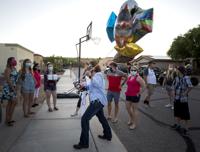
Michelle Leon Cordova, right, mother, brings celebration balloons to a car after staff members from Diamonds Children Center, friends and the Marana Police Department celebrate Sahuarita High School senior Lino Cordova, whom is fighting cancer, graduation with a car parade outside of his home on May 13, 2020 in Sahuarita, Ariz. Cordova stood on the sidewalk while the team from Diamond Children Center, friends and the Marana police department gave Cordova a graduation gar parade. Cordova was given a gift basket with his favorite snacks, gift cards as well as other items he enjoys. The car parade, also, celebrated another graduating senior fighting cancer from Empire High School, Noah Nieto. Nieto, also, received a gift basket with snacks, gift cards and other items Lino enjoys.
Tucson gets by during coronavirus pandemic
Updated
Personnel from Tucson Medical Center line the heliport to watch A-10's from Davis-Monthan Air Force Base's 355th Wing and F-16's from the Arizona Air National Guard's 162nd Wing make a pass over the facility, one leg of an area wide community flyover, May 14, 2020, Tucson, Ariz.
Tucson gets by during coronavirus pandemic
Updated
Nancy Celix-Campos, right, a respitory therapist at Tucson Medical Center, watches the military flyover with her daughters, Giana, 12, and Jazmyn, 8, from Sentinel Peak on May 14, 2020. Two F-16 Fighting Falcons from Arizona Air National GuardÕs 162nd Wing and two A-10 Thunderbolt II's from the 355th Wing, assigned to Davis-Monthan Air Force Base, fly over Tucson area hospitals to honor healthcare personnel and first responders as they are some of the frontline workers dealing with the coronavirus disease (COVID-19) head on. "It's been an exhausting two to three months," says Campos, "it's pretty cool, I like how they're going by each hospital."
Tucson gets by during coronavirus pandemic
Updated
Two F-16 Fighting Falcons from Arizona Air National Guard’s 162nd Wing and two A-10 Thunderbolt II's from the 355th Wing, assigned to Davis-Monthan Air Force Base, fly over Northwest Medical Center north of Tucson on May 14, 2020.
Tucson gets by during coronavirus pandemic
Updated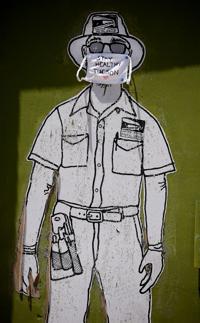
A letter carrier portrait on the Ok Market building, located in the Armory Park neighborhood, is adorned with a face mask on May 18, 2020.
Tucson gets by during coronavirus pandemic
Updated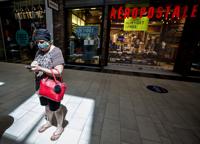
Rosemary Garcia waits for a family member outside of a store at Park Place Mall, 5870 E. Broadway Blvd., in Tucson, Ariz. on May 19, 2020. Malls reopened today under CDC guidelines and Gov. Ducey's new rules for businesses due to the Coronavirus pandemic. Park Place Mall has signs throughout the mall reminding customers to keep a six feet distance as well as hand sanitizer stations near each entrance. About half of the tables in the food court have been removed to allow for social distances as well as less than half of the stores have opened with new guidelines. Of the stores open, only 10 customers are allowed to shop in each store at a time.
Tucson gets by during coronavirus pandemic
Updated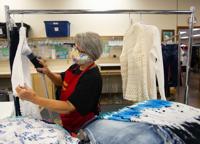
Pat Schlote steams clothing before it is put on the sales floor at the Golden Goose Thrift Shop in Catalina, Ariz., on May 21, 2020.
Tucson gets by during coronavirus pandemic
Updated
Ada Contreras, teaching assistant, looks through containers while reorganizing toys at Herencia Guadalupana Lab School, 6740 S. in Tucson, Ariz. on May 21, 2020. As Child care centers begin to re-open when they are ready, Herencia Guadalupana Lab School is reorganizing and cleaning everything in the facility before re-opening on June 2. To allow for social distancing and decrease the amount of items children touch, Herencia Guadalupana Lab School has sheds where items will go as well as placing items in containers organized by category.
Tucson gets by during coronavirus pandemic
Updated
Jen Martinez, right, softball coach, teaches Skylar Reilly about hitting during a session at Centerfield Baseball Academy, 5120 S. Julian Dr., in Tucson, Ariz. on May 21, 2020. After re-opening on Monday, Centerfield Baseball Academy has implemented new policies in response to the Coronavirus Pandemic such as wearing masks, cleaning, signage, hand sanitizer and limiting the amount of people inside the facility.
Tucson gets by during coronavirus pandemic
Updated
Karl Bosma, left, and George Cantua, with facilities and maintenance, lay down stickers to mark six-foot separation distance around one of the baggage carousels, part of the efforts at Tucson International Airport to work within the restrictions of COVID19, May 22, 2020, Tucson, Ariz.
Tucson gets by during coronavirus pandemic
Updated
A lone passenger waits for a flight near one of the shuttered restaurants in the B Gates before Memorial Day at Tucson International Airport on May 22, 2020.
Tucson gets by during coronavirus pandemic
Updated
Drew Cooper on the stage in the St. Philip's Plaza courtyard, May 22, 2020, Tucson, Ariz., where live music is back on the schedule.
Tucson gets by during coronavirus pandemic
Updated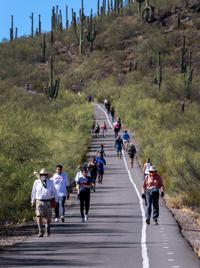
Many people visit Tumamoc Hill during the first day of Tumamoc's re-opening in Tucson, Ariz. on May 25, 2020. After being closed due to the Coronavirus pandemic, Tumamoc Hill re-opened with some modifications. There are hand sanitizer stations throughout the hike to the top as well as arrows, spaced 10-ft apart, lined up and down the hill. Some runners, hikers and walkers are also wearing masks during their hike. "The steps we are taking aim to provide our community with needed exercise, connection to our beautiful desert and a sense of comfort in such a trying time, while balancing the fact that gathering as a community endangers each of us and our loved ones. This is an unprecedented challenge that we are taking extremely seriously," said Benjamin T. Wilder, director of Tumamoc Hill. Visitors are also asked to limit their group to three people and to not touch the gate at the top of the hill- a tradition for some who make it to the top. "This is a time when we need to establish new traditions and adapt in a creative manner that embraces empathy, unity, care and patience," Wilder said.
Tucson gets by during coronavirus pandemic
Updated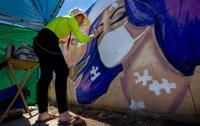
Pen Macias, artist, works on part 2 of a mural for a client on E. Broadway Rd., between S. Columbus Blvd. and S. Alvernon Way, in Tucson, Ariz. on May 25, 2020. Macias, known as The Desert Pen, has been working on her clients mural for the past three months. "It's the one thing I love, I have a passion for and the only thing I could be happy doing," said Macias. The mural represents her client, a single mother of four who works in the health care field. One half of the mural is dedicated to the connection between mothers and their children. The other half is dedicated to the connection between nurses and patients. The client wanted some positivity in the mural to show how nurses give a piece of themselves to their patients hence the puzzle pieces in the nurse and the patients, said Macias.
Tucson gets by during coronavirus pandemic
Updated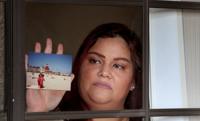
Christina Cortinas, posing at her home, May 28, 2020, Tucson, Ariz., with a photo of her and her mother, Catherine Rodriguez, in San Diego, 1991. Rodriguez is currently in assisted living and fighting COVID19. Cortinas hasn't seen her mother in months, the longest such span in her life.
Tucson gets by during coronavirus pandemic
Updated
Ruben Lopez looks through handouts while attending a Eviction Resource Fair with his family outside the Pima County Justice Court.


